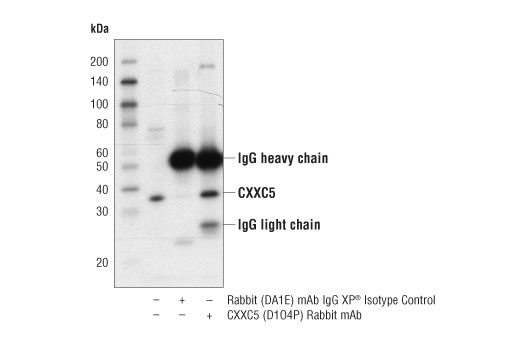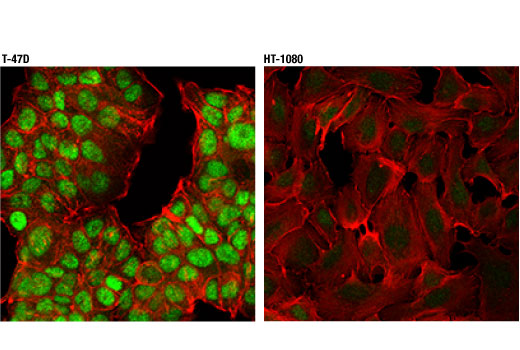WB, IP, IF-IC
H M R Mk
Endogenous
33
Rabbit IgG
#Q7LFL8
51523
Product Information
Product Usage Information
| Application | Dilution |
|---|---|
| Western Blotting | 1:1000 |
| Immunoprecipitation | 1:100 |
| Immunofluorescence (Immunocytochemistry) | 1:1000 |
Storage
Specificity / Sensitivity
Species Reactivity:
Human, Mouse, Rat, Monkey
Species predicted to react based on 100% sequence homology
The antigen sequence used to produce this antibody shares
100% sequence homology with the species listed here, but
reactivity has not been tested or confirmed to work by CST.
Use of this product with these species is not covered under
our
Product Performance Guarantee.
Bovine, Pig
Source / Purification
Monoclonal antibody is produced by immunizing animals with a synthetic peptide corresponding to residues surrounding Leu172 of human CXXC5 protein.
Background
The CXXC-type zinc finger protein 5 (CXXC5) is a nuclear protein that regulates gene expression and is involved in the regulation of cell growth and differentiation, apoptosis, cell adhesion, and cytoskeletal organization. The CXXC5 protein is also known as retinoid-inducible nuclear factor (RINF) as it was originally identified from a set of genes upregulated by retinoic acid stimulation (1). CXXC5 is a transcriptional activator of the vascular endothelial growth factor receptor VEGFR2. The CXXC5 protein regulates differentiation and migration of endothelial cells and subsequent blood vessel formation downstream of bone morphogenic protein (BMP) signaling (2). CXXC5 also regulates TNFα-induced apoptosis by facilitating phosphorylation of Smad3 and the nuclear translocation of Smad4 (3). Expression of CXXC5 in skeletal muscle regulates expression of genes involved in skeletal myogenesis (4). This nuclear factor also plays an important role in the regulation of normal myelopoiesis. The CXXC5 gene is localized to the 5q31.2 chromosomal region that is often involved in abnormalities associated with various myeloid malignancies, and CXXC5 over-expression is associated with decreased overall survival in human AML (5). Interestingly, CXXC5 is also over-expressed in many solid tumors, and high expression is also correlated with poor prognosis in breast cancer (6).
Species Reactivity
Species reactivity is determined by testing in at least one approved application (e.g., western blot).
Western Blot Buffer
IMPORTANT: For western blots, incubate membrane with diluted primary antibody in 5% w/v nonfat dry milk, 1X TBS, 0.1% Tween® 20 at 4°C with gentle shaking, overnight.
Applications Key
WB: Western Blotting IP: Immunoprecipitation IF-IC: Immunofluorescence (Immunocytochemistry)
Cross-Reactivity Key
H: human M: mouse R: rat Hm: hamster Mk: monkey Vir: virus Mi: mink C: chicken Dm: D. melanogaster X: Xenopus Z: zebrafish B: bovine Dg: dog Pg: pig Sc: S. cerevisiae Ce: C. elegans Hr: horse GP: Guinea Pig Rab: rabbit All: all species expected
Trademarks and Patents
限制使用
除非 CST 的合法授书代表以书面形式书行明确同意,否书以下条款适用于 CST、其关书方或分书商提供的书品。 任何书充本条款或与本条款不同的客书条款和条件,除非书 CST 的合法授书代表以书面形式书独接受, 否书均被拒书,并且无效。
专品专有“专供研究使用”的专专或专似的专专声明, 且未专得美国食品和专品管理局或其他外国或国内专管机专专专任何用途的批准、准专或专可。客专不得将任何专品用于任何专断或治专目的, 或以任何不符合专专声明的方式使用专品。CST 专售或专可的专品提供专作专最专用专的客专,且专用于研专用途。将专品用于专断、专防或治专目的, 或专专售(专独或作专专成)或其他商专目的而专专专品,均需要 CST 的专独专可。客专:(a) 不得专独或与其他材料专合向任何第三方出售、专可、 出借、捐专或以其他方式专专或提供任何专品,或使用专品制造任何商专专品,(b) 不得复制、修改、逆向工程、反专专、 反专专专品或以其他方式专专专专专品的基专专专或技专,或使用专品开专任何与 CST 的专品或服专专争的专品或服专, (c) 不得更改或专除专品上的任何商专、商品名称、徽专、专利或版专声明或专专,(d) 只能根据 CST 的专品专售条款和任何适用文档使用专品, (e) 专遵守客专与专品一起使用的任何第三方专品或服专的任何专可、服专条款或专似专专


